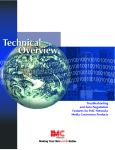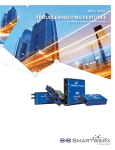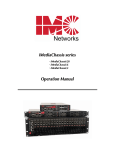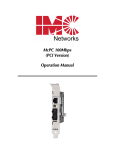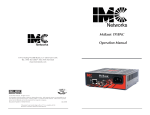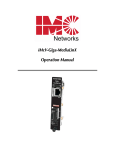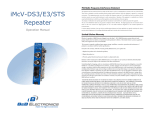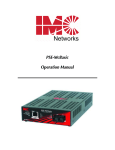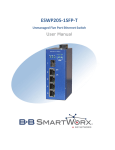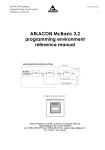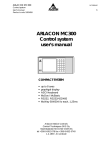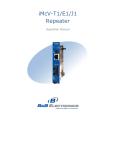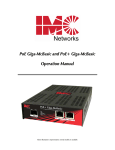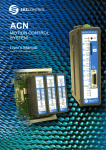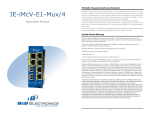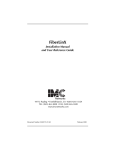Download IMC Networks SP50 User's Manual
Transcript
McBasic TP/FO & TP/BNC Operation Manual FCC Radio Frequency Interference Statement This equipment has been tested and found to comply with the limits for a Class B computing device, pursuant to Part 15 of the FCC Rules. These limits are designed to provide reasonable protection against harmful interference when the equipment is operated in a commercial environment. This equipment generates, uses and can radiate radio frequency energy and, if not installed and used in accordance with the instruction manual, may cause harmful interference to radio communications. Operation of this equipment in a residential area is likely to cause harmful interference in which the user will be required to correct the interference at his own expense. Any changes or modifications not expressly approved by the manufacturer could void the user’s authority to operate the equipment. The use of non-shielded I/O cables may not guarantee compliance with FCC RFI limits. This digital apparatus does not exceed the Class B limits for radio noise emission from digital apparatus set out in the Radio Interference Regulation of the Canadian Department of Communications. Le présent appareil numérique n’émet pas de bruits radioélectriques dépassant les limites applicables aux appareils numériques de classe B prescrites dans le Règlement sur le brouillage radioélectrique publié par le ministère des Communications du Canada. Warranty IMC Networks warrants to the original end-user purchaser that this product, EXCLUSIVE OF SOFTWARE, shall be free from defects in materials and workmanship under normal and proper use in accordance with IMC Networks' instructions and directions for a period of six (6) years after the original date of purchase. This warranty is subject to the limitations set forth below. At its option, IMC Networks will repair or replace at no charge the product which proves to be defective within such warranty period. This limited warranty shall not apply if the IMC Networks product has been damaged by unreasonable use, accident, negligence, service or modification by anyone other than an authorized IMC Networks Service Technician or by any other causes unrelated to defective materials or workmanship. Any replaced or repaired products or parts carry a ninety (90) day warranty or the remainder of the initial warranty period, whichever is longer. To receive in-warranty service, the defective product must be received at IMC Networks no later than the end of the warranty period. The product must be accompanied by proof of purchase, satisfactory to IMC Networks, denoting product serial number and purchase date, a written description of the defect and a Return Merchandise Authorization (RMA) number issued by IMC Networks. No products will be accepted by IMC Networks which do not have an RMA number. For an RMA number, contact IMC Networks at PHONE: (800) 624-1070 (in the U.S and Canada) or (949) 4653000 or FAX: (949) 465-3020. The end-user shall return the defective product to IMC Networks, freight, customs and handling charges prepaid. End-user agrees to accept all liability for loss of or damages to the returned product during shipment. IMC Networks shall repair or replace the returned product, at its option, and return the repaired or new product to the end-user, freight prepaid, via method to be determined by IMC Networks. IMC Networks shall not be liable for any costs of procurement of substitute goods, loss of profits, or any incidental, consequential, and/or special damages of any kind resulting from a breach of any applicable express or implied warranty, breach of any obligation arising from breach of warranty, or otherwise with respect to the manufacture and sale of any IMC Networks product, whether or not IMC Networks has been advised of the possibility of such loss or damage. EXCEPT FOR THE EXPRESS WARRANTY SET FORTH ABOVE, IMC NETWORKS MAKES NO OTHER WARRANTIES, WHETHER EXPRESS OR IMPLIED, WITH RESPECT TO THIS IMC NETWORKS PRODUCT, INCLUDING WITHOUT LIMITATION ANY SOFTWARE ASSOCIATED OR INCLUDED. IMC NETWORKS SHALL DISREGARD AND NOT BE BOUND BY ANY REPRESENTATIONS OR WARRANTIES MADE BY ANY OTHER PERSON, INCLUDING EMPLOYEES, DISTRIBUTORS, RESELLERS OR DEALERS OF IMC NETWORKS, WHICH ARE INCONSISTENT WITH THE WARRANTY SET FORTH ABOVE. ALL IMPLIED WARRANTIES INCLUDING THOSE OF MERCHANTABILITY AND FITNESS FOR A PARTICULAR PURPOSE ARE HEREBY LIMITED TO THE DURATION OF THE EXPRESS WARRANTY STATED ABOVE. Every reasonable effort has been made to ensure that IMC Networks product manuals and promotional materials accurately describe IMC Networks product specifications and capabilities at the time of publication. However, because of ongoing improvements and updating of IMC Networks products, IMC Networks cannot guarantee the accuracy of printed materials after the date of publication and disclaims liability for changes, errors or omissions. ii Table of Contents FCC Radio Frequency Interference Statement ....................................................ii Warranty............................................................................................................ii About the McBasic .............................................................................................1 Installing the McBasic.........................................................................................1 Configuring McBasic ..........................................................................................1 Twisted Pair Crossover/Straight-Through Switch..................................................1 BNC Port Termination........................................................................................2 LinkLoss and Pulsing FiberAlert ..........................................................................2 LED Operation...................................................................................................5 Installation Troubleshooting ...............................................................................7 Specifications .....................................................................................................8 Fiber Optic Cleaning Guidelines.......................................................................10 Electrostatic Discharge Precautions...................................................................10 Safety Certifications..........................................................................................11 iii Notes iv About the McBasic The McBasic series consists of low-cost, IEEE 802.3 single-conversion, 1U high, standalone media converters. The McBasic TP/FO converts 10Base-T twisted pair to 10Base-FL multi-mode or single-mode fiber and includes one RJ-45 connector and one pair of ST or SC connectors. McBasic TP/BNC converts 10Base-T twisted pair to 10Base-2 thin coax and includes one RJ-45 connector and one BNC connector. Each McBasic includes diagnostic LEDs and an internal 100/240 VAC power supply. Installing the McBasic McBasic comes ready to install; configure after installation. To install McBasic, first make sure that the unit is placed on a suitable flat surface. Attach the cables between the McBasic and each device that will be interconnected, then plug the unit into a reliable, filtered power source. NOTE The McBasic TP/FO does not auto-negotiate, therefore IMC Networks does NOT recommend connecting it to a switch, media converter or other device that ONLY auto-negotiates; connect to a device that is 10 Mbps or to a device that you can force to 10 Mbps. Configuring McBasic Once installed, configure McBasic TP/FO for the following: • A crossover or pass-through connection for the twisted pair port • Pulsing FiberAlert Once installed, configure McBasic TP/BNC for the following: • A crossover or pass-through connection for the twisted pair port • BNC port termination (default = Enabled) Twisted Pair Crossover/Straight-Through Switch The twisted pair port on McBasic TP/FO and McBasic TP/BNC features a pushbutton switch, located next to the twisted pair connector, for selecting a crossover workstation connection or straight-through repeater/hub connection. Select a straight-through connection by pressing the push-button IN. A crossover connection is selected when the push-button is OUT. If uncertain whether a crossover or straight-through connection is needed, set the push-button to the position that makes the TP LNK (link) LED glow. 1 BNC Port Termination McBasic TP/BNC features a 2-position switch next to the BNC connector that allows a thin coaxial segment to be terminated at the port without an additional ‘T’ connector and terminator. If McBasic TP/BNC is attached to a mid-point of a thin Ethernet segment, attach a ‘T’ connector to the BNC port. Termination must be OFF (disabled). Termination is disabled when the switch is in the left position. If a thin Ethernet segment is to be terminated at the McBasic TP/BNC, attach the cable directly to the BNC connector and set the termination switch to ON (enabled –factory default) by moving the switch to the right position. LinkLoss and Pulsing FiberAlert LinkLoss and Pulsing FiberAlert are advanced troubleshooting features from IMC Networks that can help you locate “silent failures” on your network. It is vital that you understand exactly how Pulsing FiberAlert and LinkLoss work and how they will react in your network configuration before attempting to install the enclosed unit. ** WARNING ** Installing media converters without understanding the effects of Pulsing FiberAlert can cause perfectly functioning units to appear flawed or even dead! If you are unfamiliar with Pulsing FiberAlert and LinkLoss, IMC Networks strongly encourages you to read the following information. Contact IMC Networks technical support at (800) 624-1070 (U.S./Canada), +32-16-550880 (Europe) or [email protected] for more information and assistance. 2 About Link Integrity During normal operation, link integrity pulses are transmitted by all point-to-point Ethernet devices. When an IMC Networks media converter receives valid link pulses, it knows that the device to which it is connected is up and sending pulses, and that the copper or fiber cable coming from that device is intact. The appropriate “LINK” LED is lit to indicate this. The IMC Networks media converter also sends out link pulses from its copper and fiber transmitters, but normally has no way of knowing whether the cable to the other device is intact and the link pulses are reaching the other end. The combination of FiberAlert and LinkLoss allows this information to be obtained, even when physical access to a remote device (and its link integrity LED) is not available. FO LinkLoss FO LinkLoss is a troubleshooting feature. When a fault occurs on the fiber segment (receive side) of a conversion, FO LinkLoss detects the fault and passes this information to the twisted pair segment. If a media converter is not receiving a fiber link, FO LinkLoss disables the transmitter on the media converter's twisted pair port. This results in a loss of link on the device connected to the twisted pair port. TP LinkLoss TP LinkLoss is another troubleshooting feature. When a fault occurs on the twisted pair segment of a conversion, TP LinkLoss detects the fault and passes this information to the fiber segment. If a media converter is not receiving a twisted pair link, TP LinkLoss disables the transmitter on the media converter's fiber port. This results in a loss of link on the device connected to the fiber port. Configuring LinkLoss TP LinkLoss and FO LinkLoss are always enabled on McBasic TP/FO. Neither is offered on McBasic TP/BNC. 3 Pulsing FiberAlert Pulsing FiberAlert minimizes the problems associated with the loss of one strand of fiber. If a strand is unavailable, the IMC Networks device at the receiver end notes the loss of link. The device will stop transmitting data and start sending link pulses. Until a valid link is received, the fiber link LED will be OFF on the device on the receiver side of the fiber strand with the fault while the fiber Link LED on the other unit will blink. Pulsing FiberAlert notifies a local site administrator of a fault, allowing quick determination of where a cable fault resides. NOTE You can enable Pulsing FiberAlert on BOTH sides of a conversion. Configuring Pulsing FiberAlert McBasic TP/FO features an 8-position DIP switch located on the bottom of the unit for configuring Pulsing FiberAlert after installation. To enable Pulsing FiberAlert, move the switch labeled “FA Pulse” to the ON position. After configuring the DIP switch, power down the unit and then power up again for the changes to take effect. The default setting for this feature is shown to the right. Switches 5-8 are factory-configured; DO NOT change. If unsure of how to best implement these features in your configuration, please contact IMC Networks Technical Support at (800) 6241070 (U.S. and Canada); +32-16-550880 (Europe). 4 LED Operation Each McBasic features diagnostic LEDs. The following illustrations show the location of the LEDs, and other features, on McBasic TP/FO and McBasic TP/BNC. The LED functions for McBasic TP/FO are as follows: • TP LINK Glows green if link is established on the TX port. • TP ACT Glows amber when data is being passed on the TX port. • FA PULSE Glows green when Pulsing FiberAlert is enabled. • PWR Glows green when unit has power. • FO LINK Glows green when link is established on the FX port. • FO ACT Glows green if data is being passed on the FX port. 5 The LED functions for McBasic TP/BNC are as follows: • TP RCV Flickers amber when twisted pair port is receiving data. • TP LNK Glows green when a twisted pair link is established. • BNC COL Flickers red in normal operation indicating normal collisions are being detected on the BNC segment. • BNC RCV Flickers amber when BNC port is receiving data (On a -20 McBasic TP/BNC, the TP RCV and BNC RCV LEDs flicker at a rate proportional to the rate that the data is passing on the ports. Under low traffic conditions, the LEDs flicker visibly, while they appear to glow under high traffic conditions.) 6 Installation Troubleshooting • During installation, first test your fiber and twisted pair connections with all troubleshooting features disabled. Then enable these features, if desired, just before final installation. This will reduce the interference from features upon testing. • To test McBasic TP/FO by itself, you must have an appropriate fiber patch cable. First, connect McBasic TP/FO to the twisted pair device with a twisted pair cable and establish valid link. Next, loop a single strand of fiber from the transmit port to the receive port of your media converter. Finally, verify that you have both twisted pair and fiber link on your media converter. • Make sure that you are using the appropriate twisted pair cable or have the crossover/pass-through button on the media converter set correctly. • Interconnection between the Next Generation of McBasic TP/FOs, iMcV-PIM TP/FOs and McPIM TP/FOs and their Legacy counterparts is possible. Where possible, however, use Legacy with Legacy product, or Next Generation with Next Generation product. • When connecting the fiber port of a McBasic TP/FO to a 100 Mbps fiber port of the link partner or another media converter, an unlabeled LED located at the top of the fiber LED stack will glow amber, indicating the presence of a configuration fault. To correct this fault, you must configure the end-device to force 10 Mbps mode. 7 IMC Networks Technical Support Tel: (949) 465-3000 or (800) 624-1070 (in the U.S. and Canada); +32-16-550880 (Europe) Fax: (949) 465-3020 E-Mail: [email protected] Web: www.imcnetworks.com Specifications Power AC Input Load: 100/240V±10% ~ 50/60 Hz, 0.1/0.05A Operating Temperature: 32° to 104° F (0° to 40° C) Storage Temperature: -4° to 158° F (-20° to 70° C) Humidity: 5 to 90% (non-condensing); 0 to 10,000 ft. altitude Shipping weight: 1.3 lbs. (0.6 kg) 8 Dimensions: McBasic TP/FO 1.68”H x 4.75”W x 4.95”D (4.3 cm x 12.1 cm x 12.6 cm) McBasic TP/BNC 1.68"H x 4.75"W x 4.53"D (4.3 cm x 12.1 cm x 11.5 cm) 9 Fiber Optic Cleaning Guidelines Fiber Optic transmitters and receivers are extremely susceptible to contamination by particles of dirt or dust, which can obstruct the optic path and cause performance degradation. Good system performance requires clean optics and connector ferrules. 1. Use fiber patch cords (or connectors, if you terminate your own fiber) only from a reputable supplier; low-quality components can cause many hard-to-diagnose problems in an installation. 2. Dust caps are installed at IMC Networks to ensure factory-clean optical devices. These protective caps should not be removed until the moment of connecting the fiber cable to the device. Should it be necessary to disconnect the fiber device, reinstall the protective dust caps. 3. Store spare caps in a dust-free environment such as a sealed plastic bag or box so that when reinstalled they do not introduce any contamination to the optics. 4. If you suspect that the optics have been contaminated, alternate between blasting with clean, dry, compressed air and flushing with methanol to remove particles of dirt. Electrostatic Discharge Precautions Electrostatic discharge (ESD) can cause damage to your add-in modules. Always observe the following precautions when installing or handling an add-in module or any board assembly. 1. Do not remove unit from its protective packaging until you’re ready to install it. 2. Wear an ESD wrist grounding strap before handling any module or component. If you do not have a wrist strap, maintain grounded contact with the system unit throughout any procedure requiring ESD protection. 3. Hold boards by the edges only; do not touch the electronic components or gold connectors. 4. After removal, always place the boards on a grounded, static-free surface, ESD pad or in a proper ESD bag. Do not slide the board over any surface. WARNING! Integrated circuits and fiber optic components are extremely susceptible to electrostatic discharge damage. Do not handle these components directly unless you are a qualified service technician and use tools and techniques that conform to accepted industry practices. 10 Safety Certifications UL/CUL: Listed to Safety of Information Technology Equipment, including Electrical Business Equipment. CE: The products described herein comply with the Council Directive on Electromagnetic Compatibility (89/336/EEC) and the Council Directive on Electrical Equipment Designed for use within Certain Voltage Limits (73/23/EEC). Certified to Safety of Information Technology Equipment, Including Electrical Business Equipment. For further details, contact IMC Networks. Class 1 Laser product, Luokan 1 Laserlaite, Laser Klasse 1, Appareil A’Laser de Classe 1 European Directive 2002/96/EC (WEEE) requires that any equipment that bears this symbol on product or packaging must not be disposed of with unsorted municipal waste. This symbol indicates that the equipment should be disposed of separately from regular household waste. It is the consumer’s responsibility to dispose of this and all equipment so marked through designated collection facilities appointed by government or local authorities. Following these steps through proper disposal and recycling will help prevent potential negative consequences to the environment and human health. For more detailed information about proper disposal, please contact local authorities, waste disposal services, or the point of purchase for this equipment. 11 19772 Pauling • Foothill Ranch, CA 92610-2611 USA TEL: (949) 465-3000 • FAX: (949) 465-3020 www.imcnetworks.com © 2008 IMC Networks. All rights reserved. The information in this document is subject to change without notice. IMC Networks assumes no responsibility for any errors that may appear in this document. McBasic is a trademark of IMC Networks. Other brands or product names may be trademarks and are the property of their respective companies. Document Number 55-80226-01 A2 April 2008 If the product’s part number begins with an “8”, it is compliant with the Restriction of Hazardous Substances (RoHS) directive.
















